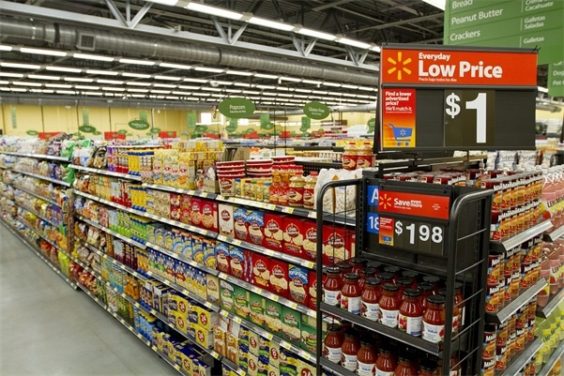
If you live in a small city like Atchison, Kansas or Portales, New Mexico, or a medium-sized metro area like Amarillo, Texas or Joplin, Missouri – or in any one of hundreds of communities across the country – it’s practically a given that you do your regular grocery shopping at Walmart. That’s because you may not have much of a choice. And to one advocacy group, that’s a serious problem.
The Institute for Local Self-Reliance, a nonprofit group that promotes “sustainable community development” and “challenges concentrated economic and political power” is out with a new report that takes on the largest retailer in the world – and calls on the federal government to do the same.
In more than 200 metropolitan areas and smaller markets across America, the group’s analysis shows that Walmart captures more than half of all grocery sales. In 38 of those markets, Walmart’s grocery share is 70% or more. In the aforementioned Atchison and Portales, where the only other choices are small neighborhood markets or dollar stores with a limited grocery selection, Walmart earns an astounding 95% of all grocery dollars.
“For communities, this lack of competition has consequences,” the report reads. “Walmart’s near-total market control gives it extraordinary power to decide which foods and brands are available locally and thus to shape what people buy and eat. It can raise prices, or cut service, or suddenly pull a popular product from its shelves, with little risk of losing customers.”
The group faults lax federal oversight that allowed Walmart to grow so large and become so dominant. “Convinced that big companies were more efficient and therefore better for consumers, the Justice Department and Federal Trade Commission decided to give large corporations more leeway to use their size and financial might to crush smaller competitors and seize market power,” the group argues. This “has left a remarkable number of places without a competitive market for even the most basic of daily needs.”
Walmart’s dominance is heavily concentrated in smaller communities in the Midwest and the Southern U.S. But there are some larger cities on the ILSR’s list, including Oklahoma City, a metro area of more than 1.3 million people. The area is served by national grocers like Whole Foods Market and Trader Joe’s, and regional chains like WinCo Foods and Homeland, yet Walmart still earns 60% of all grocery sales.
So the group is calling on the federal government to act. Its report makes three key recommendations to help “deliver dozens of communities from the monotony and risk of relying on a single absentee corporation for their daily bread.”
First, it wants regulators to more aggressively enforce antitrust laws, to restrict “predatory pricing and buyer power”. It calls on policymakers to “reverse banking consolidation and establish grocery-focused lending programs… to enable local entrepreneurs to start grocery businesses” that can provide “distinct consumer and community benefits that large chains can’t match.”
And most notably, the group wants the government to force Walmart to sell off stores. “The Federal Trade Commission should review the 203 markets in which Walmart controls 50% or more of grocery sales and, in as many as is feasible, compel the retailer to divest stores,” the report recommends.
But how likely is that? In many small communities, the issue isn’t that there are so many Walmart locations that other grocers simply can’t compete. It’s that a single local Walmart location is just about the only grocery game in town. If Walmart were forced to pull out of these communities, any notion that local mom-and-pop grocers will emerge to benevolently serve their neighbors seems anachronistic and naive. It’s more likely that these communities’ grocery choices will be limited to dollar stores, mini-marts and few real grocery retailers at all.
And in a larger market like Oklahoma City, which has plenty of grocery retailers, Walmart’s dominance merely suggests that a majority of people are shopping there not because they don’t have any other options, but simply because they want to. Forcing Walmart to scale back in such a community could end up limiting consumers’ choices, not expanding them.
That doesn’t mean many small-town shoppers wouldn’t be happier if they didn’t find themselves at Walmart quite so often. A resident of Portales, New Mexico laments on the online review site Yelp that the local Walmart “is pretty disappointing, which is unfortunate because they are one of the few shopping centers around.” A resident of North Platte, Nebraska, where Walmart has an 87% share of the grocery market, complains that “the checkout lines are always obscenely long. The associates could not be less helpful… It is unfortunate that this is the only large grocery store in town.” And in Wahpeton, North Dakota, where Walmart gets 84% of the local grocery business, “customer service is a joke,” one reviewer writes. “You have no other choice if you need something while in this town, but clearly Walmart knows that.”
In his 2011 book The Great A&P and the Struggle for Small Business in America, author Marc Levinson compared Walmart’s dominance of the 21st century grocery industry with A&P’s dominance in the first half of the 20th century. “Walmart was widely accused of destroying the trade of small-town merchants; similar charges were raised against A&P from 1869 into the 1950s,” he wrote. “Walmart’s competitors, like A&P’s many years before, sought to slow the retail giant’s growth by tapping into public anxieties arising from the disruption of familiar ways, the loss of local uniqueness, the vulnerability to distant economic forces.”
The Institute for Local Self-Reliance raises the specter of A&P as well, but points out that A&P accounted for 16% of U.S. grocery sales at its peak in 1933. Walmart’s market share today is about 25%, meaning it “captures $1 in $4 that Americans spend on groceries,” the report states. “That’s more than the market share of the next five largest supermarket chains combined.”
The federal government ultimately intervened to keep A&P’s growing market share in check, and “the grocery chain continued to be a strong competitor for many decades,” the ILSR report notes. “Dismantling Walmart’s market power would have a similar effect today. Walmart would continue to be a buyer and seller of groceries. But it would no longer be an overbearing force.”
Of course, it’s worth noting that A&P eventually went bankrupt and ceased to exist. When A&P began faltering, competitors moved in. And when shoppers no longer liked what A&P was offering, they voted with their feet. So with or without government intervention, today’s monopolist can easily turn into tomorrow’s memory.
But for grocery shoppers in places like Atchison and Portales, Amarillo and Joplin, who have virtually nowhere else to shop but Walmart – the ILSR hopes its call to action will help turn that lack of choice into a memory as well.
Image source: Walmart










